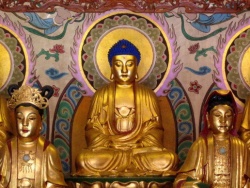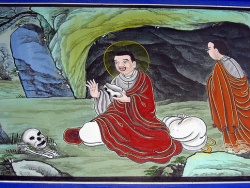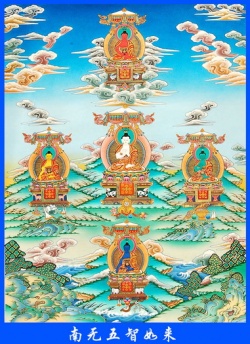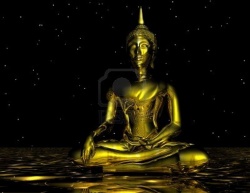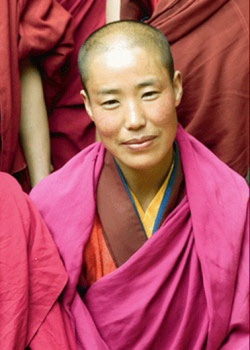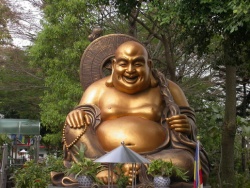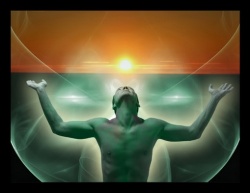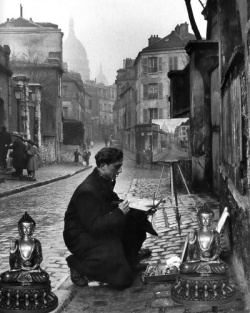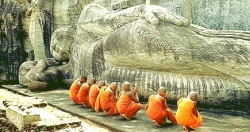Mahayana and,,,
by Venerable Master Shen-Kai
The myriad of things and phenomena in this world are formed by aggregations of numerous causes and conditions comprising four elements: earth, water, fire and wind. As such, they do not have independent natures of their own. A tree, for example, is the result of a combination of nutrients, water, sunlight and air. Thus, they are in fact empty because when the conditions that created and sustained them are no longer present, these objects will return to emptiness. However, we don't see them in this light. We think they are real, absolute and permanent. But they are not. They are dependent upon other conditions. We need to truly comprehend and awaken to this fundamental truth of emptiness.
The phrase 'all form is non-form' is from the Diamond Sūtra.
Buddha said, "Subhūti, what do you think? Can we use our ordinary flesh-eyes to see the Tathāgata’s physical form and thus believe we are seeing the true Tathāgata ?"
Subhūti replied, "No, World-honoured One. We cannot look upon the unreal form of the Tathāgata’s manifestation and think we have perceived the non-arising and non-ceasing true body of the Tathāgata."
How is that? The 16-foot physique of the Tathāgata is a bodily form produced by an aggregation of causes and conditions. When life ends, that body decays and eventually vanishes. It is not the truly pure Dharma-kāya of the Tathāgata because the Dharma-kāya has no form to be seen; it is empty and tranquil. How could flesh-eyes of sentient beings see the true form of the Tathāgata’s Dharma-kāya?
Buddha told Subhūti, "Not only is the Tathāgata’s bodily form a false form produced by the aggregation of causes and conditions, which does not have real substance, so is any kind of thing in the universe, in this world as well as beyond this world. All living and non-living things, shapes and colours are merely formed by aggregations of causes and conditions. They are impermanent and will change as causes and conditions disperse. They are as illusory as the flower in the mirror or the moon in the water!
"If looking at appearances of objects, sentient beings are able to lucidly awaken to its aggregation of causes and conditions, and understand impermanence, their arising and ceasing; and if at that very instant, distinguishing does not arise, then without discrimination, they can enter into deep stillness. In stillness, pure wisdom reveals itself. With supreme wisdom, they realise that all worldly form is created by causes and conditions. Its nature is empty; it is not reality. In this way, they will directly perceive the Tathāgata’s Dharma-kāya."
Subhūti was the Arahat who best understood emptiness. Thus, with regards to emptiness, he had profound realisation. We see this in a story:
Once, Buddha went to the heavenly palace of Trayastrimśās to preach Dharma to his mother. He only returned to earth after having been gone for a few months. All of his disciples missed him. When he returned, they rushed to welcome him, each hoping to be the first to pay their respects to him. Being the most advanced in supernatural ability amongst the Buddha's female disciples, Bhiksunī Lián-huā-sè (蓮花色) used her supernatural powers and transformed herself into the image of Saint-king Cakravartī. Then, with great poise, she went to stand right up in front. She very happily paid her respects to Buddha and said, "Disciple Lián-huā-sè is the first to pay respects to Buddha today. Oh, I’m overjoyed!"
Buddha replied with a smile, "Lián-huā-sè, the first to see the Tathāgata wasn’t you. It was Subhūti!"
Bhiksunī Lián-huā-sè was astonished! Subhūti had not joined in the queue to welcome the Buddha. How could he have been the first to meet the Buddha?
Buddha then said, "The bodily form of the Tathāgata is not seen by our perceptions. He who sees the Dharma, sees the Tathāgata."
As it turned out, when Buddha returned to earth, Subhūti had been in the meditation hall sitting in stillness, deeply observing the emptiness of all things and phenomena, clearly understanding the reality of inherent emptiness, and thus realising the formless Dharma-kāya of Tathāgata. Even though he had not been there in the queue, he had in fact truly seen the Tathāgata.
Buddha has three bodies (Trikāya). One is 'Nirmānakāya'(化身), or the 'Emanation Body'. According to the sentient beings' capacity for understanding, Buddha manifests the illusory forms of physical bodies in numerous worlds. Because of their heavy karmic hindrances, some disciples were only able to see the 16-foot golden body of the Buddha, but were unable to see the 32 physical characteristics and 80 accompanying physical features of a great person (i.e. Dvātrimśadvara-laksana and Anuvyañjana).
Another body of Buddha is 'Sambhogakāya' (报身), or the 'benefiting body', of which are two kinds: one is the 'body which benefits oneself', and the other is the 'body which benefits others'. The former is the Buddha's own attainment and awakening to his meritorious intrinsic pure Buddha-nature, in the state of Dharma joy. The latter is the appearance of enlightened, liberated Bodhisattvas to guide beginner-Bodhisattvas (i.e. sentient beings who emulate Bodhisattvas and practise the Bodhisattva Way) according to prevailing causalities, enabling these beginner-Bodhisattvas to benefit from the teachings of Greater Vehicle (Mahāyāna) with Dharma joy. Both Nirmānakāya and Sambhogakāya are physical forms which are visible. However, the perfect Sambhoga-kāya of Great Bodhisattvas is a form that is infinite and of awesome majesty. It is not something that ordinary sentient beings like us can see. What ordinary people see is the Nirmāna-kāya form.
The third body of Buddha, named 'Dharma-kāya'(法身), is the Truth Body of the Tathāgata, and also the reality of all phenomena. It permeates all of space and is omnipresent. An ancient sage said, "Green bamboos are entirely Dharma-kāya, luxuriant chrysanthemums are all Prajñā; each grass, each tree, all in the ocean of Buddha-nature. Green bamboos are used for expressing the state of Dharma-kāya, but bamboos are by no means Dharma-kāya. Luxuriant chrysanthemums are used for displaying the function of Prajñā, but chrysanthemums are by no means Prajñā."
The myriad of things and phenomena in this world are formed by aggregations of numerous causes and conditions comprising four elements and five skandhas , arising by causality and ceasing by causality; their nature is inherently empty. And everything in the world is as such. They do not exist as individual entities. Hence, the nature of all things and phenomena is empty, tranquil and all pervasive. However, people are unaware of this and are grasping on to their belief that the numerous forms in the universe truly exist. But if you can truly comprehend this and awaken to the realisation that the nature of all forms is emptiness, then instantaneously you perceive the pure Dharma-kāya of Tathāgata.
Before explaining how the sukha-tathagatagarbhikas explain the "apparent conflict", and Chan too, let's take a few steps back.
Even in the early sutras, there is the idea of certain teachings as being "fully drawn out" (nitartha), and others as "yet to be drawn out" (neyartha). We could say, "explicit" and "implicit". However, at first, which were which was not stated.
So, there were some "apparent conflicts" quite early on. The biggest by far was that of the "pudgala", which was kind of a synonym for "atman". In some sutras the Buddha says things like "the pudgala does this and that", "the pudgala is reborn in some place", and so forth; and in other sutras, the Buddha states that "there is no atman, no pudgala, no sattva..." and so forth.
Now, one school, the Pudgalavadins, tried to come up with a theory that kept all teachings on a similar "truth" level. They ended up with an "expressible pudgala", which was rather dubious. Still, they tended to fall towards the extreme of eternalism, rather than annihilism. So, although neither are correct, the former is better than the latter (see my signature).
The other schools, notably the Abhidharma groups, came up with the "dharma theory", which broke everything down into irreducible parts, each of which was impermanent, dissatisfactory and not self (and empty too). Now, based on a group of these irreducible dharmas, one could have a designation, but these desigations / names, etc. were not real per se. Classic example: The five aggregates are real, the "person" is a designation based on the aggregates.
They then used this theory to explain the apparent contradiction, ie. that teachings that spoke of a "pudgala", "atman", etc. were actually just "conventional designations" and thus "implicit" and "to be fully drawn out", whereas thos that taught in terms of "dharmas", were "ultimate teachings" and "already fully drawn out". (I've an essay in my Blog, see signature, on this one if you want more details.)
To seal this, the Abhidharma literature which is slightly later than the sutras almost always tries to use the "dharma" / "ultimate" terminology. Therefore, a bunch of later explanatory literature wins the day.
But, there were still some problems with this Abhidharma dharma-theory. In particular, the tendency towards explaining these irreducible dharmas as somehow substantial. In fact, even up to the point of the Sarvastivada considering dharmas as themselves little atman, etc. (Remember, the Sarvastivada is from a school closely related to the Pudgalavadins.) Again, a slight leaning towards eternalism.
Now, another body of literature starts to appear, ie. the Mahayana sutras. Once again, they have the advantage of being the latest texts, so they can make arguments against all the earlier material, and consolidate a complete systematic view. The emphasis is on the fact that even these so-called Dharmas are empty too, not just empty of an atman / pudgala, but empty of any sort of substantiality, eternality, and so forth.
But, again, this has the tendency towards nihilism in the eyes of some. So, yet another body of literature starts to appear. Well, two, actually. These are the Yogacara literature, stemming from the Sarvastivadins. And, the Tathagatagarbha literature.
Because they are now the newest stuff, they can explicity within the text themselves say things like "Oh, the XXX sutra is just a provisional teaching, this sutra that you are reading now is the real, true and ultimate teaching!!" And, of course, the XXX sutra doesn't say anything to the contrary - because this new Tathagatagarbha sutra didn't even exist at the time to be refuted!!
Every new batch of literature that came out stated that it (and usually, only it), was the "explicit" and ultimate teaching, etc. etc. and that everything that had come before was merely provisional.
In India, this was nitartha versus neyartha. But in China, slightly different. The Chinese for a start received a lot of their Buddhism "all at once", or, at least in a quite different order at first to the Indians. ie. they got Abhidharma stuff first, then some Mahayana stuff, and then the Agama sutras, and then mostly Mahayana stuff with some later commentaries of Abhidharma and Mahayana.
So, mainly starting from Tiantai Zhiyi, they started to make "doxographies", and try to put the various sutras in order - of time, and importance. Of course, they considered (almost) every text that had "Thus have I heard..." to be all taught during the Buddha's time. However, because the later texts claimed to be more ultimate, etc. they ended up being put later in the Buddha's career.
eg. whereas modern scholars would say that the range of sutras, early and Mahayana, took place over about 8 centuries, Zhiyi crammed them all within the life time of Sakyamuni. First, the Avatamsaka, then the Agamas, then the Prajnaparamita, then the Vaipulyas (other Mahayana sutras), then the Lotus Sutra and finally the Mahayana Parinirvana Sutra.
Actually, the Mahayana Parinirvana Sutra (not to be confused with the early Parinirvana Sutra) was a genius idea! If they set the sutra at the parinirvana of the Buddha, then obviously it would have to be the Buddhas last (and thus ultimate) teaching! And yes, this was a Tathagatagarbha text.
All these were already translated, and the Tiantai doxography already in place, by the time that Chan came on the scene. So, the Mahayana sutras, especially the Tathagatagarbha sutras, were supreme. For Chan at first, the Lankavatara Sutra was extremely important, but also the Parinirvana, etc. Lotus, etc.
During the first few generations of Chan, they mainly used these Mahayana sutras as the basis of their practice. Bodhidharma cites them, so do Daoxin, Hongren and Huineng. It's called "based on the scripture, realize the mind / truth". This later came to be called "Ruali Chan", "rulai" being the translation of "tathagata", referring to the Tathagatagarbha sutras.
Later, in the late Tang and Song, etc. there was a move towards "patriarch Chan". Though the Sutra content was there, it was less obvious, and there was usage of techniques like "silent illlumination", "word/thought watching", etc. Still, most of these were based around later Mahayana thought, especially Tathagatagarbha. There were some exceptions, but they were minor.
It was in this later period that Chan goes to Japan and we have Zen. Also, a lot of Zen in Japan is Tendai influenced, so the notion of the importance of the Lotus Sutra and Parinirvana Sutra is perhaps even stronger than in China.
These Chan and Zen boys and girls were largely not scholars by this stage. Thus, where the Indian pandits were quickly putting Tathagatagarbha at the bottom end of their doctrinal scale of "which teaching is ultimate", subsuming it under a Madhyamaka (and Yogacara) over-system, the Chinese (and Japanese) did not. Nobody was really going around noting that "Hey, these buddhists are talking like the Vedantins or Brahmins!?", because there weren't (m)any Brahmins in China! Everything Indian got subsumed into the Buddhist fold.
Also, around the late Tang, the routes to India were not as open, and so the latest Indian explanations did not make it to China. Unlike in Tibet, which is the time when Buddhism started there. Their Tathagatagarbha and Yogacara was already largely the later, pre-packaged in Madhyamaka outfit version, and so it stayed.
The Mantra 'Buddho'
If you've got a really active thinking mind, you may find the mantra 'Buddho' helpful. Inhale on 'Bud' and exhale on '-dho' so you're actually thinking this for each inhalation. This is a way of sustaining concentration: so for the next fifteen minutes, do the anapanasati, putting all your attention, composing your mind with the mantric sound, 'Bud-dho'. Learn to train the mind to that point of clarity and brightness rather than just sinking into passivity. It requires sustained effort: one inhalation of 'Bud' - fully bright and clear in your mind, the thought itself raised and bright from the beginning to the end of the inhalation, and '-dho' on the exhalation. Let everything else go at this time. The occasion has arisen now to do just this - you can solve your problems and the world's problems afterwards. At this time this much is all the occasion calls for. Bring the mantra up into consciousness. Make the mantra fully conscious instead of just a perfunctory passive thing that makes the mind dull; energise the mind so that the inhalation on 'Bud' is a bright inhalation, not just a perfunctory 'Bud' sound that fades out because it never gets brightened or refreshed by your mind. You can visualise the spelling so that you're fully with that syllable for the length of an inhalation, from the beginning to the end. Then '-dho' on the exhalation is performed the same way so that there's a continuity of effort rather than sporadic leaps-and-starts and failures.
Just notice if you have any obsessive thoughts that are coming up - some silly phrase that might be going through your mind. Now if you just sink into a passive state, then obsessive thoughts will take over. But learning to understand how the mind works and how to use it skilfully, you're taking this particular thought, the concept of 'Buddho' (the Buddha, the One Who Knows), and you're holding it in the mind as a thought. Not just as an obsessive, habitual thought, but as a skilful use of thought, using it to sustain concentration for the length of one inhalation, exhalation, for fifteen minutes.
The practice is that, no matter how many times you fail and your mind starts wandering, you simply note that you're distracted, or that you're thinking about it, or you'd rather not bother with 'Buddho' - 'I don't want to do that. I'd rather just sit here and relax and not have to put forth any effort. Don't feel like doing it.' Or maybe you've got other things on your mind at this time, creeping in at the edges of consciousness - so you note that. Note what mood there is in your mind right now - not to be critical or discouraged, but just calmly, coolly notice, if you're calmed by it, or if you feel dull or sleepy; if you've been thinking all this time or if you've been concentrating. Just to know.
The obstacle to concentration practice is aversion to failure and the incredible desire to succeed. Practice is not a matter of will-power, but of wisdom, of noting wisdom. With this practice, you can learn where your weaknesses are, where you tend to get lost. You witness the kind of character traits you've developed in your life so far, not to be critical of them but just to know how to work with them and not be enslaved by them. This means a careful, wise reflection on the way things are. So rather than avoiding them at all costs, even the ugliest messes are observed and recognised. That's an enduring quality. Nibbana[3] is often described as being 'cool'. Sounds like hip talk, doesn't it? But there's a certain significance to that word. Coolness to what? It tends to be refreshing, not caught up in passions but detached, alert and balanced.
The word 'Buddho' is a word that you can develop in your life as something to fill the mind with rather than with worries and all kinds of unskilful habits. Take the word, look at it, listen to it: 'Buddho'! It means the one who knows, the Buddha, the awakened, that which is awake. You can visualise it in your mind. Listen to what your mind says - blah, blah, blah, etc. It goes on like this, an endless kind of excrement of repressed fears and aversions. So, now, we are recognising that. We're not using 'Buddho' as a club to annihilate or repress things, but as a skilful means. We can use the finest tools for killing and for harming others, can't we? You can take the most beautiful Buddha rupa and bash somebody over the head with it if you want! That's not what we call 'Buddhanussati', Reflection on the Buddha, is it? But we might do that with the word 'Buddho' as a way of suppressing those thoughts or feelings. That's an unskilful use of it. Remember we're not here to annihilate but to allow things to fade out. This is a gentle practice of patiently imposing 'Buddho' over the thinking, not out of exasperation, but in a firm and deliberate way.
The world needs to learn how to do this, doesn't it? - the U.S. and the Soviet Union - rather than taking machine guns and nuclear weapons and annihilating things that get in the way; or saying awful nasty things to each other. Even in our lives we do that, don't we? How many of you have said nasty things to someone else recently, wounding things, unkind barbed criticism, just because they annoy you, get in your way, or frighten you? So we practise just this with the little nasty annoying things in our own mind, the things which are foolish and stupid. We use 'Buddho', not as a club but as a skilful means of allowing it to go, to let go of it. Now for the next fifteen minutes, go back to your noses, with the mantra 'Buddho'. See how to use it and work with it.
